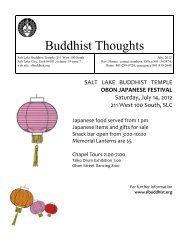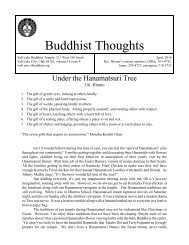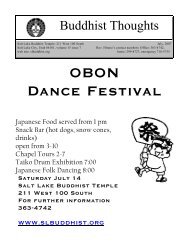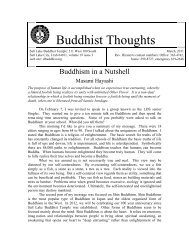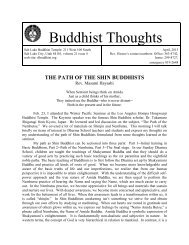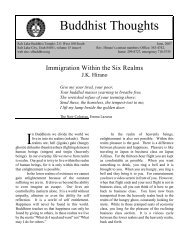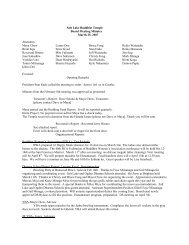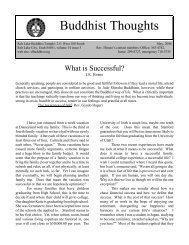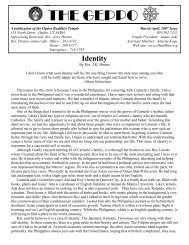Buddhist Thoughts - Salt Lake Buddhist Temple
Buddhist Thoughts - Salt Lake Buddhist Temple
Buddhist Thoughts - Salt Lake Buddhist Temple
You also want an ePaper? Increase the reach of your titles
YUMPU automatically turns print PDFs into web optimized ePapers that Google loves.
to take part and to conduct the Kieshiki ceremony. Those who would like to receive their<strong>Buddhist</strong> name should fill out the application form and return it to Rev. Hirano by February 1.The following is information sent out by BCA concerning the ceremony’s meaning.The Meaning of the CeremonyIn this Shin <strong>Buddhist</strong> ceremony, performed before the altar of Amida Buddha andShinran Shonin by the Bishop (Socho) of the BCA, one takes the important step of affirmingone’s reverence for the Buddha, Dharma, and Sangha, and one’s determination to tread the pathto Buddhahood. When the ceremony is conducted by the Monshu, spiritual head of the JodoShinshu Hongwanji-ha denomination, the ceremony is referred to as the Kikyoshiki ConfirmationCeremony.The Three Refuges in General <strong>Buddhist</strong> TraditionIn the time of Shakyamuni Buddha, one was permitted to join the <strong>Buddhist</strong> community(sangha) upon receiving the precept of the three refuges under the guidance of a monk andshaving one’s head.To receive the precept of the three refuges means to declare before one’s teacher that onetakes wholehearted refuge in the Buddha, Dharma, and Sangha, and to vow that one will notdeviate from them.“Buddha” here refers to Sakyamuni, “Dharma” to Sakyamuni’s Teaching, and “Sangha”to the community of followers who have entrusted themselves to Sakyamuni Buddha’s teaching.Because these form the basis of what one values most in one’s life, they are called the “threetreasures.”Shaving one’s head symbolizes departure from the worldly ways of life and entrance intoa life devoted to the path of Buddhism, which transcends the mundane world.The Affirmation CeremonyThe teachings of Sakyamuni Buddha are so extensive that they are said to number84,000. It is no surprise, then, that after the Buddha’s death, various schools developed based onthe different aspects of his teachings. Shin Buddhism (Jodo Shinshu) is the <strong>Buddhist</strong> path ofgreat compassion clarified by Shinran Shonin. Shinran teaches that Sakyamuni appeared in thisworld in order to reveal the Vow of Amida Buddha to save all beings; it is the salvation of allpeople by Amida Buddha that is Sakyamuni’s fundamental teaching.The Affirmation Ceremony in Shin Buddhism, therefore, shares a common meaning withthe precept of the three refuges administered in the time of Sakyamuni Buddha, but it also has aspecial meaning. In the Affirmation Ceremony, the Buddha of the three refuges is not simplySakyamuni, but refers especially to Amida Buddha, who is the heart of Sakyamuni’s teachings.Sakyamuni came into the world to teach the Vow of Amida Buddha, and our salvation is broughtabout by Amida. Thus, “Dharma” is the teaching of Amida’s compassionate working to save allbeings, and “Sangha” refers to people who have entrusted themselves to Amida.Since there are no precepts in Shin Buddhism, instead of receiving the precept of thethree treasures, one participates in the Affirmation Ceremony.



